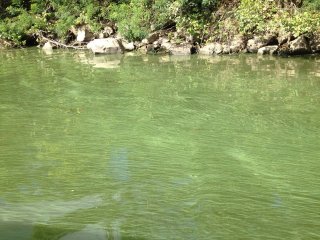EPA Research in West Virginia
EPA researchers are working hard to protect communities across the nation. Learn about some of the work EPA researchers are doing in West Virginia.
- Characterization of HABs on the Ohio River
- Emissions Measurement Methods
- Environmental DNA (eDNA) for Species Inventory
- Atmospheric Deposition of Nitrogen in the Chesapeake Bay
- River Spill Model
- Stream Monitoring Network
- EPA Ecotoxicity Tool Improves Access to Chemical Information
- Helping Community Drinking Water Systems Find Cost-Effective Solutions to Treatment Challenges
For more EPA work, see EPA in West Virginia.
Characterization of HABs on the Ohio River

“The West Virginia Department of Environmental Protection arranged for a flyover of the Ohio River in the fall of 2015, which documented that the Ohio River was an ‘antifreeze green’ color from bank to bank for several hundred miles." In 2015, an unprecedented algal bloom in the Ohio River caught many communities by surprise. Since then, EPA researchers have been working with water quality managers to address a gap in scientific research regarding the ability to predict harmful algal blooms on rivers. Read A Better Way: An Application for Risk Characterization of HABs on the Ohio River.
Emissions Measurement Methods
Oil and natural gas production have increased significantly within Utah’s Uinta Basin, Colorado’s Denver-Julesburg Basin, West Virginia’s Marcellus Shale, and across the United States over the last decades. Oil and natural gas extraction and production activities co-emit volatile organic compounds, and greenhouse gases directly to the atmosphere. EPA's Office of Research and Development, in collaboration with Region 8, is working with Utah and Colorado state officials and oil and gas operators to conduct emissions research on pneumatic controllers used in upstream production. The collaboration will ultimately support better development of US energy assets in ways that also protect human health and the environment.
Environmental DNA (eDNA) for Species Inventory
Conservation and management of endangered species require being able to locate populations and determine their distribution in the environment. To provide support to various state agencies, including West Virginia Division of Natural Resources, and in collaboration with EPA Region 3, EPA Region 9, the U.S. Fish and Wildlife Service (USFWS) Pennsylvania Field Office, and the University of Kentucky Department of Forestry, EPA scientist developed eDNA tools and assessed the capability of eDNA to determine distribution and relative abundance of species of concern.
Atmospheric Deposition of Nitrogen in the Chesapeake Bay
Working in collaboration with the EPA Region 3 Chesapeake Bay Program, EPA Office of Research and Development scientists developed a consistent long term emissions dataset and tailored the Community Multiscale Air Quality (CMAQ) modeling system so that it could be used to estimate atmospheric nitrogen deposition for historical (2002 – 2019), and future (2035, 2050) scenarios. The work was conducted to assist partner states, including West Virginia, and watershed managers.
River Spill Model
EPA researchers developed a web-based River Spill Modeling System (RSMS) software that enables accurate 2-D modeling of spills in rivers. Water utilities can use RSMS to decide if they temporarily should close an intake, add additional treatment, or access alternative water supplies, if available. RSMS has been used by the Ohio River Valley Water Sanitation Commission (ORSANCO), an interstate commission representing eight states including West Virginia, on spills that have occurred on the Ohio River and its tributary system for many years.
Stream Monitoring Network
EPA's Office of Research and Development is working with EPA regions, states (including West Virginia), Tribes, river basin commissions and other entities to establish Regional Monitoring Networks for freshwater wadeable streams. The objectives are to collect long-term biological, thermal, hydrologic, physical habitat and water chemistry data to document baseline conditions across sites and detect long-term changes. This data can be used for many purposes, including informing water quality and biological criteria development and setting protection planning priorities, refining lists of biological, thermal and hydrologic indicators, and detecting trends in commonly used water quality and biological indicators.
EPA Ecotoxicity Tool Improves Access to Chemical Information
EPA’s web-based Ecotoxicology Knowledgebase houses toxicity effects data on over 11,000 chemicals and 12,000 species, including aquatic life, terrestrial plants, and wildlife. Users can explore the curated data on the effects, if any, of specific chemicals on different species of fish or native plants. In the 2014 Elk River chemical spill, when crude 4-methylcyclohexanemethanol was released from a tributary into the Elk River in West Virginia, ECOTOX provided access to unpublished EPA toxicity data to assess potential risks to fish. Read EcoTox 5.0 Improves Access to Chemical Information on Ecological Species.
Helping Community Drinking Water Systems Find Cost-Effective Solutions to Treatment Challenges
Emerging contaminants, such as per- and polyfluoroalkyl substances (PFAS), are challenging to drinking water systems across the country. Effective treatment for emerging contaminants can be unknown, difficult, and extremely costly. EPA researchers are providing technical assistance to a small community water system with PFAS concerns to help them identify optimal, cost-effective treatment methods and optimize the long-term operation of their chosen technology. These efforts will also be used to develop best practices and performance and cost estimate tools so water utilities across the country can make informed treatment and operational choices. Read Technical Assistance for Treatment Options to Remove Emerging Contaminants.
